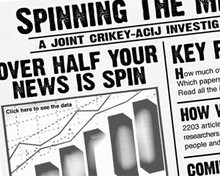
During the course of six months, 40 students from University of Technology (UTS) Sydney worked with independent media site Crikey to monitor Australian news content in ten newspapers, seven of which are owned by Rupert Murdoch's News Corporation.
"As newspaper pages continue to be pruned and journalism jobs carved back, Crikey and the University of Technology Sydney were interested in investigating just to what extent Australia's major papers rely on the public relations machine to generate column inches," editor Sophie Black told Journalism.co.uk.
"Our investigation strongly confirms that journalism in Australia today is heavily influenced by commercial interests selling a product, and constrained and blocked by politicians, police and others who control the media message."
Nearly 55 per cent of stories analysed in a five day period (more than 2203 articles) were instigated by public relations, Crikey reported. The worst performer was the Murdoch-owned tabloid, the Daily Telegraph: 70 per cent of stories were PR driven. The best of the ten papers was Fairfax's Sydney Morning Herald with 42 per cent PR prompted stories for that week.
The study, which requires a subscription to read in full, says that it defined journalism as PR driven "if it was instigated from a press release or some other form of promotional material; or if a story clearly presented only one, highly positive slant or framed one source in a promotional manner without including any independent verification or additional source".
It also reported that of 2203 articles, more than 24 per cent, "had no significant extra perspective, source or content added by reporters".
"The highest levels of PR content were found in the innovation/technology (77 per cent) and police (71 per cent) areas.
[Methodology detail here]
Not all the journalists approached wanted to speak to the students, but Chris Mitchell, editor in chief of The Australian, told a UTS student:
"It's very difficult I think, given the way resources have drifted from journalism to public relations over the past 30 years, to break away as much as you really want to … I guess I'm implying that the number of people who go to communications school and go into PR over the years has increased and the number in journalism has shrunk even more dramatically."
[More responses here]
"As Australian journalists struggle from a lack of resources and time, and editors continue to make cuts, the ever growing PR industry has increasingly stepped into the breach," said Sophie Black.
"While news consumers still trust journalists to dig up their stories, they'd be surprised to find that at times journalists simply cut and paste the presser hot off the fax, don't go beyond the one source's take on events and in some cases never even pick up the phone."
Pots and kettles?
In the comments on Crikey, however, some have criticised the findings. 'LoafingOaf' for example, says he find the exercise a bit of 'spin' itself:
"What you appear to have identified is that the original source for a journo in generating a story is a media release in over 50 per cent of cases. If your survey identified that journos were then writing a story based completely on that release uncritically, not seeking alternative viewpoints and simply regurgitating a corporate or party political PR line or worse still just rehashing the release itself, I'd say we have a problem. But that is categorically not the case, nor is it what your research shows."
Another, Stuart Mackenzie, writes to Crikey suggesting the exercise was in fact its own bit of spin - for the Australian Centre for Independent Journalism:
"It appears that no Crikey journalist was involved in writing any of the stories - at least there is no by-line - and it appears that no checking of the statistics was done during the editorial process."
The exercise is similar to Nick Davies' UK-based research conducted with Cardiff University for his book Flat Earth News (2008). As he described in a piece for the Guardian in 2008, his team surveyed more than 2,000 UK news stories from five newspapers:
"They found two striking things. First, when they tried to trace the origins of their 'facts', they discovered that only 12 per cent of the stories were wholly composed of material researched by reporters. With eight per cent of the stories, they just couldn't be sure. The remaining 80 per cent, they found, were wholly, mainly or partially constructed from second-hand material, provided by news agencies and by the public relations industry. Second, when they looked for evidence that these 'facts' had been thoroughly checked, they found this was happening in only 12 per cent of the stories."
It's not the first time the Australian press has come under fire for his PR-hungry news:
Last October ABC's Hungry Beast spread a story that Sydney is the most gullible city in Australia, according to the completely fabricated Levitt Institute:
Please add your thoughts about the exercise in the comments below.
Free daily newsletter
If you like our news and feature articles, you can sign up to receive our free daily (Mon-Fri) email newsletter (mobile friendly).
Related articles
- Why Australia's bid to make big tech pay for news failed: views from an indie publisher
- Five tips for reporting on the UK Home Office
- Ideas for innovating public interest news: The Australian Newsroom Mapping Project
- Considering the 'dark side'? Advice for those looking to switch from journalism to PR
- Should I let the source read my article before publication?









